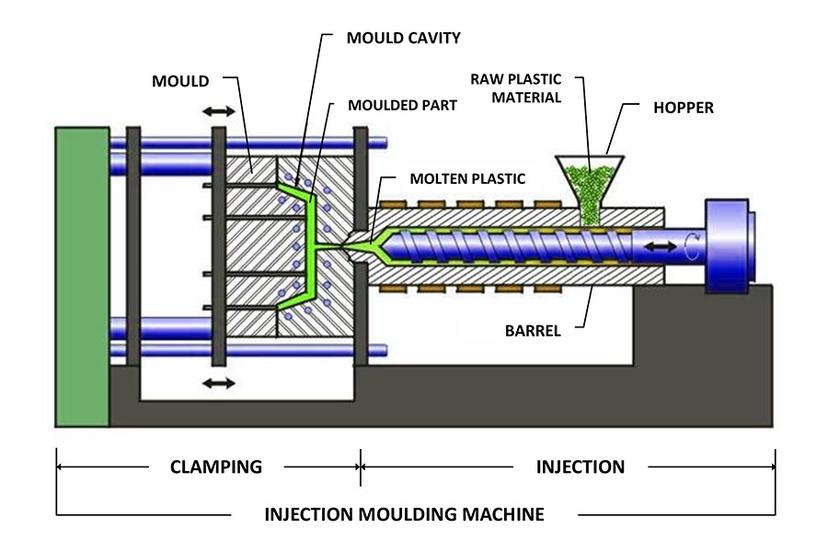Injection molding, as a coremoldingtechnology in the plastic processing industry, is widely used in the production of various plastic products due to its high efficiency, precision and flexibility. With the continuous advancement of technology and the diversification of market demands, injection molding technology has also developed various types to meet the processing needs of different materials and products. Longsheng will introduce several common types of injection moldingin detail to help you understand this technology more comprehensively.
What is Injection Molding?
Injection moldingis a process in which granular or powdery plastic materials are fed into the barrel of theinjection molding machine, heated, melted and plasticized, and then pressurized by the screw to compress and move the material forward, and then pass through the nozzle at the front end of the barrel. A molding method in which the mold is injected into a closed mold with a lower temperature at a high speed, and after a certain period of cooling and shaping, the mold is opened to take out the product.
It is most commonly used for large-scale manufacturing of plastic parts due to low material waste and low cost per part. This is an ideal manufacturing process for industries such as medical devices, consumer goods, and automotive.

What Are the Types of Injection Molding?
1.Thermoplastic Injection Molding
Thermoplastic injection molding is to melt the thermoplastic materialand inject it into the mold cavity through high pressure of the injection molding machine. After cooling and solidification, a plastic product of the desired shape is obtained.
Features
- Plastic materials can be heated and cooled repeatedly and are thermoplastic.
- The production speed is fast, the efficiency is high, and it is suitable for mass production.
- The products have precise dimensions and good surface quality, and can produce products with complex shapes.
Application
Widely used in automobiles, electronics, home appliances, toys and other fields, such as car bumpers, instrument panels, TV casings, etc.

2.Liquid silicone rubber molding (LSR molding)
Liquid silicone rubber molding is to mix two or more liquid silicone rubber compounds, thensilicone moldingand solidify them through a mold to obtain silicone products with soft, elastic, high temperature resistance and other characteristics.
Features
- The raw material is liquid, has good fluidity, and can fill the complex structure of the mold.
- It has excellent physical properties and chemical stability after curing.
- The products are soft and elastic, and are suitable for products that require sealing, shock absorption, conductivity and other properties.
Application
Used to manufacture silicone products in O-rings, gaskets, conductive buttons, medical equipment and other fields.
3.Overmolding
Overmolding is a molding methodin which plastic is injected onto a primary component to increase its strength, hardness, wear resistance or aesthetics.
Features
- Plastic can be directly injected onto existing parts to achieve material compounding.
- It reduces secondary operations and assembly costs and improves production efficiency.
- The product has beautiful appearance and solid structure.
Application
It is widely used in automotive interior parts, electronic product casings, furniture components and other fields.
4.Insert molding
Insert molding is a process in which metal or other material inserts are placed into the mold cavity while the mold is open, and then the mold is closed forinjection-molding.
Features
- The composite of metal and plastic is realized, which improves the strength and durability of the product.
- Suitable for producing plastic products with metal inserts, such as electrical switches, connectors, etc.
- Precise mold design and manufacturing is required to ensure a perfect fit of the insert to the plastic.
Application
Used in the manufacture of complex plastic products in electrical appliances, automobiles, electronics and other fields, such as casings with metal inserts, connectors, switches, etc.
How Does the Injection Molding Process Work?
Stage 1: Clamping
Clamping, also called mold closing, is the first step and preparationstage of molding injection. At this stage, both sides of the mold are placed into the mold clamping unit, and the machine then pushes the two halves of the mold together to ensure that the mold is tightly closed and ready for the subsequent injection process. The tightness of the mold clamping will directly affect the melt flow and molding quality of the subsequentplastics injectionprocess. If the mold is not closed tightly, it will cause the plastic melt to leak, affecting the integrity and appearance of the product.
Stage 2: Injection
The injection stage is the most critical step inplastic molding. The injection molding machine feeds the plastic raw materials into the injection molding cavity. The raw materials are heated and melted in the injection molding cavity, and then injected into the closed mold cavity at high pressure and high speed through the nozzle. During the injection process, the plastic melt needs to fill the mold cavity and cover all mold cavity surfaces to ensure that the product can be formed correctly.
Stage 3: Cooling
After injection is completed, the mold needs to be left alone to cool. During this stage, the plastic melt inside the mold gradually cools and solidifies into a solid form. The length of cooling time depends on the type and thickness of the plastic material and the cooling efficiency of theplastic moldings.
Stage 4: Ejection
With the mold open, an ejector bar will slowly push the solidified product out of the open mold cavity. The fabricator should then use cutters to eliminate any waste material and perfect the final product for customer use. Waste material can often be recycled and reinjected for the next part, decreasing your material costs.

What Are the Advantages of Injection Molding?
| Advantages | Description |
| Complex parts design and manufacturing capabilities | Injection molding can handle highly complex part designs, providing consistency and the ability to manufacture millions of nearly identical parts. |
| Quality consistency | The injection molding production process helps ensure consistent quality because the same mold continues to be used for every part. |
| Low labor cost | Labor costs for injection molding operations are relatively low compared to other types ofmolding designprocesses.High productivity and the ability to produce parts at a high level help reduce manufacturing costs through efficiency and effectiveness. |
| Low waste | Themolding plasticprocess produces very little waste compared to many other manufacturing processes. Even if there is any unused or discarded plastic, you can recycle it for future use. |
| Various material options | Injection molding stands out for its versatility and is available in a variety of material options. The process is compatible with a variety of polymers, each bringing unique properties and aesthetics to the final product. From strong plastics used in automotive parts to flexible materials used in consumer products, injection molding has a wide range of material options to meet a wide range of industry needs. |
| Repeatability | An important aspect of injection molding is its excellent repeatability. This process ensures that each product is nearly identical, providing a high degree of consistency and uniformity in batch production. |
| High efficiency | While it can take minutes or even hours to 3D print or CNC a part, most injection molding cycles last only 10 to 60 seconds. Even if you have complex geometry that takes about 120 seconds to mold, you can fit several smaller parts into a larger mold. This helps maximize efficiency and get the most out of each mold, allowing you to manufacture hundreds of identical parts per hour at low cost. |
What Are the Different Types of Injection Molding Machines?
Hydraulic injection molding machine
Hydraulic injection machines mainly rely on hydraulic power to provide injection force. When creatingmolding plasticparts, the temperature of the machine should also be managed and varied; otherwise, scrap can easily occur. Hydraulic injection molding machines should be operated frequently to prevent the machine from being damaged due to inactivity.
Advantages
- Lower Price: The base price of these machines is significantly lower than other similar products.
- Cheaper Parts: If a part on your machine needs to be replaced because it's damaged or the part has reached the end of its life, replacement parts are less expensive and easier to find.
- Stronger Components: The machine's hydraulic components are more resistant to wear and tear - built to last.
- Power: Hydraulic forming machines have excellent clamping force.
Electric Injection Molding Machine
Electric injection molding machinesrepresent a leap forward in manufacturing technology, using electric servo motors for all movements, allowing for precise control and energy efficiency.
Advantages
- Energy efficiency: Electric injection molding machines consume energy only when running, that is, the motor output is only equal to the output required by the load.
- Less downtime: No chance of oil leakage. Plus, no oil means no filters to change, which means less consumables bills.
- Faster process: These machines are digitally controlled, meaning the process is completely repeatable and requires no supervision.
- Clean operation: Since this machine does not use oil, it is safe to use if you manufacture medical parts. Typically, these parts should be manufactured in a clean room area.

Hybrid injection molding machine
Hybrid injection molding machines combine the best features of hydraulicand electric motors to achieve a balance between performance, energy efficiency and cost.
- Variety: The possible combinations of hybrid injection molding machines open up new design flexibility.
- The best of both worlds: Hybrid molding machines combine the energy savings and accuracy of an electric molding machine with the power generation capabilities of a hydraulic unit.
- Motor replacement: The hybrid has replaced the constant-speed DC pump motor with a variable-speed AC drive, so the pump only runs when needed and uses the necessary amount of oil to improve process efficiency.
- Less Downtime: These molding machines require less maintenance and less downtime than fully hydraulic or fully electric molding machines.
- Price Point: Priced between fully hydraulic and fully electric forming machines, it is an affordable option. Especially suitable for medical device manufacturers.
What Materials Are Used in Injection Molding?
| Material | Advantages |
| Acrylonitrile-butadiene-styrene (ABS) | Engineering grade thermoplastic, low melting point, easy to form, high strength, high impact resistance, tough and relatively cheap, resistant to heat, oil, acid and alkali, supports coloring and different textures and surface treatments |
| Acrylic (PMMA) | Strong and clear, lightweight, shatterproof, excellent optical clarity, high tensile strength, sunlight and weather resistant, suitable for outdoor use, does not absorb odors, maintains tight tolerances, BPA free |
| Nylon | High toughness, good heat resistance, strong wear resistance, good fatigue resistance, good noise reduction effect, low friction coefficient, suitable for high friction and wear applications, sunlight resistance can be improved by adding UV stabilizer |
| Polycarbonate (PC) | Naturally clear, strong and tough, maintains physical properties over a wide temperature range, retains color and strength after tinting, very durable, 250 times stronger than glass, predictable and uniform mold shrinkage, provides precise dimensional control |
| Polyethylene (PE) | Commonly used plastics with various properties depending on density, such as chemical resistance, etc. HDPE and LDPE differ in hardness, flexibility, melting point and optical transparency, are low-cost, moisture-proof and chemical-resistant |
| Polyoxymethylene (POM) | Engineering plastics, also known as acetal, can be injection molded into parts with low friction, high stiffness and excellent dimensional stability. They have excellent stiffness, thermal stability and low coefficient of friction, low water absorption and good chemical resistance. |
| Polypropylene (PP) | Similar to polyethylene but harder and more heat-resistant, with a lower density, it is the second most commonly used plastic in the world |
| Polystyrene (PS) | High transparency, good processing performance, low cost, easy to color and shape |
| Polyether Ether Ketone (PEEK) | Heat resistant, flame retardant, high strength, dimensionally stable |
| Polyvinyl Chloride (PVC) | Sturdy, impact resistant, flame resistant, insulative |
| Polyurethane (TPU) | Cold resistant, abrasion resistant, sturdy, good tensile strength |
Why Choose Longsheng for Injection Molding Services?
At Longsheng, whether you need prototype parts manufacturing or mass production, we have the corresponding capabilities and experience to meet your needs. We are committed to providing reliable, quality parts to assist you with success in the competitive automotive market.
Rapid quotation:Just upload the CAD file, you can quickly understand the manufacturing cost and keep abreast of the order status.
Quick molding:Longsheng has extensive experience in prototype manufacturing, ensuring that your components are completed with high quality in the later stages of the design and manufacturing process.
ISO attestation:Longsheng is a ISO 9001 certified manufacturing company, which means that we employ internationally recognized best practices to develop your products and ensure that they meet the standards, regardless of the complexity of the design.
Customized on demand:Our auto parts manufacturing process is fully customizable according to your specifications, sizes, materials and surface requirements to ensure meeting your unique needs.
Express delivery:We are committed to providing, fast manufacturing and delivery to meet your production needs while providing you with greater flexibility to quickly respond quickly to market changes. Longsheng is a partner of your auto parts needs.
FAQs
1.What are the transparent basic types of injection machines?
Injection molding machines are mainly divided into three types: hydraulic injection molding machines, electric injection molding machines and hybrid injection molding machines according to different driving methods and functional characteristics. Each type has its own unique advantages and applicable scenarios. The choice of various types of injection molding machines needs to be decided based on specific needs and budget.
2.What are the four types of molding?
The four common types of molding are thermoplastic injection molding, liquid silicone rubber molding (LSR molding),overmolding, insert molding, each type has its own unique technical characteristics and application scenarios. In practical application, it is necessary to choose the appropriate injection molding type according to the specific product requirements and process conditions..
3.What are the 4 stages of injection molding?
Stage 1: Clamping - In this stage, both sides of the mold are put into the mold locking unit, and then the machine pushes the two halves of the mold together to ensure that the mold is tightly closed and ready for the subsequent injection molding process. Second stage: Injection - The injection stage is the most critical step in injection molding. The injection molding machine feeds the plastic raw materials into the injection mold cavity. The raw materials are heated and melted in the injection mold cavity, and then injected into the closed mold shape through the nozzle at high pressure and high speed. in the cavity. Stage 3: Cooling-After injection is completed, the mold needs to be left to cool. During this stage, the plastic melt inside the mold gradually cools and solidifies into a solid form. Stage 4: Ejection - As the mold opens, the ejector pin slowly pushes the solidified product out of the open mold cavity. The manufacturer should then use cutters to remove any scrap and perfect the final product for customer use.
4.What are the 3 common classifications of injection molds?
Classified by plastic material category: divided into thermoplastic injection molds and thermosetting plastic injection molds. Thermoplastic injection molds are used to process thermoplastic plastics, such as polyethylene, polypropylene, etc.; thermosetting plastic injection molds are used to process thermosetting plastics, such as phenolic plastics, epoxy resins, etc. Classified by the number of mold cavities: they are divided into single-cavity injection molds and multi-cavity injection molds. A single-cavity injection mold can only produce one product at a time; a multi-cavity injection mold can produce multiple products at the same time, improving production efficiency. Classified by mold installation method: divided into mobile injection molds and fixed injection molds. Mobile injection molds can be easily moved and installed; fixed injection molds are usually fixed on the injection molding machine and are difficult to move.
Summary
lnjection molding technology can be divided into various types according to different materials, process characteristics and application requirements. Each type has its unique technical characteristics and application scenarios. In actual applications, it is necessary to select the appropriate injection molding type according to specific needs and process conditions. With the continuous advancement and innovation of technology, injection molding technology will play an important role in more fields, providing more possibilities for product design and manufacturing.
Disclaimer
The content on this page is for reference only. Longsheng does not make any express or implied representation or warranty as to the accuracy, completeness or validity of the information. No performance parameters, geometric tolerances, specific design features, material quality and type or workmanship should be inferred as to what a third party supplier or manufacturer will deliver through the Longsheng Network. It is the responsibility of the buyer seeking a quote for parts to determine the specific requirements for those parts.Please contact us for more information.
Longsheng Team
This article was written by multiple Longsheng contributors. Longsheng is a leading resource in the manufacturing sector, withCNC machining,sheet metal fabrication,3D printing,injection molding,metal stamping, and more.






